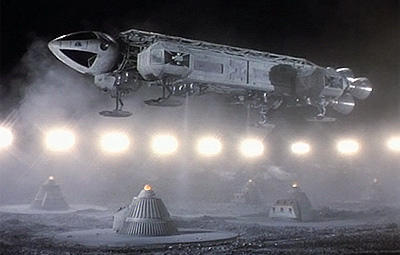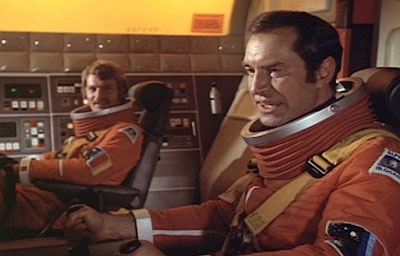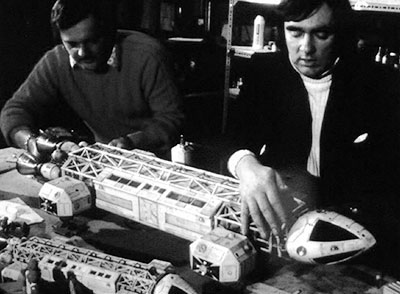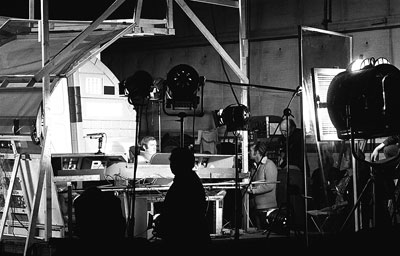The Rules of Fiction: Fantasy Technology
Monday, November 5th, 2012 • Writing
In 1965, during the planning stages of Star Trek, creator Gene Roddenberry was concerned about how to portray planetary exploration on his new show—not because of the (projected) limited resources of space travel, but because of the (very real) limited resources of television. Would Roddenberry’s spacefarers actually need to land their “Starship Enterprise” every week? The objections were irrefutable, from a TV-production standpoint: it takes too long; it’s too complicated…and the story can’t get moving until ten minutes into the episode (after a laborious “landing” sequence). Plus it’s expensive; creating footage of all that landing and taking off (the way Roddenberry was probably picturing it back then: something akin to the post-George-Pal effects in Forbidden Planet or When Worlds Collide), given the primitive production values and the tiny budget of the show, would be impossibly expensive.
So, in a stroke of genius, he invented the “transporter,” the famous machine that instantly moves characters from place to place as arbitrarily as a magic spell. This is the only reason “Beam me up, Scotty” exists: to expedite and cheapen (literally) the TV storytelling. “Energize!” shouts Captain Kirk, and (with a lap dissolve, superimposed backlit glitter and a sound effect) he and all other relevant characters are immediately placed directly into the story—it’s a deus ex machina in reverse. (Later, the proto-cellphone “communicator”—and its indispensability with regard to “locking on” to a transportee’s “signal”—was invented purely because the transporter made it correspondingly too easy to get out of the story—with Kirk’s communicator stolen or disabled, he’s trapped in place and can’t run away from the plot; he’s got to solve the problem himself.)
Note that that “transporter” has nothing to do with reality; like the “warp drive” (which facilitates faster-than-light travel) it’s a completely fanciful conceit; an invention that belies the emphasis Roddenberry was placing on realism and believability for the simple reason that, without this miraculous “technology,” there could be no Star Trek. Arthur C. Clarke had already decreed that “any sufficiently advanced technology is indistinguishable from magic;” Gene Roddenberry effectively took him at his word.
Flash forward ten years and Gerry Anderson is creating Space: 1999. The post-moon-landing, post-Kubrick ethos of his new show is clear: absolute realism. No transporters; no “warp drive”—only “real world” technology based on the NASA missions that have by now already taken place. (The historical immediacy is right in the show’s title.) Instead of magical technology, Anderson would have “Eagles” (Apollo reference duly noted): meticulously-designed, sturdy, multipurpose transport craft (see images above). “Moonbase Alpha” would have an entire fleet of them, and a crew of pilots, techs etc. All very realistic: NASA-style pipe superstructures; visible jets from the engines; space suits with air tanks and fishbowl helmets; shock absorbers that bounce during landings; big tanks of fuel; special landing platforms; complicated instrument panels surrounding the two pilots as in an old Gemini capsule; hulls covered with metal sheeting and protruding rocket-engine jets and grime and utilitarian paint schemes (yellow-and-black “caution” stripes etc.).
From a TV production standpoint, it’s fantastic-looking, because Anderson had one of the highest budgets ever given to a British syndicated TV show (and had already developed a mature, sophisticated approach to practical SFX using miniatures during his Thunderbirds puppet-show days). So Brian Johnson, Nick Allder and Martin Bower (who would go on to win Oscars for Alien and The Empire Strikes Back) could create amazing shots of detailed models with real compressed-air engine jets and of the Eagles flying with the “astronauts” visible in the windows. They quickly amassed a “library” of Eagle shots: takeoffs, landings, orbital approaches, banking turns etc. that they could use any time “for free.” And of course, the “interior” elements of Eagle flights are just more studio set shots: Dressing up actors in those realistic spacesuits and filming them in the Eagle cockpit set cost the same as filming the same actors standing around inside the Moonbase.
But the result of all this is a wild imbalance in the storytelling. Remember that Roddenberry was trying to save time and money—but by coming up with the “transporter” he invented what’s presumably a cost-effective technology within the narrative; the Enterprise can refuel and restock its provisions, and anyway the “transporter” (we are repeatedly told) simply drains “energy” from the main “dilithium-powered” engines and the (appropriately) mysterious 23rd Century power train they depend on. So beaming people up and down over and over (as happens during any normal episode) makes sense.
However Moonbase Alpha has severely limited resources (and much is made of this every episode). They can’t refuel or restock; if they lose any of their personnel or resources (including the precious fleet of Eagles) there’s no way to get any of it back. (And, a 52-minute “hour” of television hadn’t gotten any longer.) In this context, launching an Eagle would be an incredibly risky and expensive last resort—like activating a fuel cell or turning on the cabin heat inside the Apollo 13.
But it happens constantly. The Moonbase inhabitants keep flying the Eagles back and forth, over and over. John Koenig, their “Commander” (Martin Landau) will launch Eagles at the slightest provocation, and then send more Eagles after them to intercept them, bring them back, dock with them, shoot them down. Eagles crash on the lunar surface (very gently, so as not to damage the expensive models), they blow up; they’re crushed by gravitational forces and by interstellar “anemones;” they tumble off into space. And Koenig launches more Eagles, in long montage sequences of launch pad model shots and “astronauts” running down corridors and pilots in cockpits reciting NASA-style launch jargon. Because nothing’s actually happening; it’s just library footage and a few practical model shots unique to the episode (without optical effects) and actors elsewhere on the same stage pretending to stare through cockpit windows that don’t even exist. (All the Eagle interiors are the same set, which has no front.) It’s more expensive to show Starsky and Hutch driving somewhere; you’ve got to go on location with a car. On Space: 1999 it’s just a different room and another trip to the film library. The result of all Gerry Anderson’s innovations is an incredible waste of time (real and imagined) and fictional resources in every episode, although the net costs for the filmmakers are the same (and nobody is asked to believe in a “transporter”).
So the price of “realism” is less realism. The whole phenomenon reveals the strange psychological balance of science fiction and fantasy: it doesn’t matter how little actual sense the premises (or their execution) make. It only matters how real it seems, and in this case it’s less a question of physics and economics than of the right number of pipes and wires and metallic sound effects and flashing lights and complex verbal jargon—and the correct balance of scenes and confrontations and dramatic suspense through the four acts of an hour-long television drama. Just as The Godfather‘s documentary-style photography and subtitles and faux-historicism create the impression of journalistic reality (although the novel’s and movie’s portrait of mafia crime ranges from outlandishly misleading to fantastical) and John le Carré’s shabby, threadbare, ideologically-tortured MI6 is really no more accurate than Ian Flemming’s version, science fiction and fantasy traffic in a more intense version of the same conjuring trick, by which “believability” appears to emerge through narrative/representative logic but really operates like dreams—the sensual feel of an imaginary environment, its consistency and recognizable fabric, inspires acceptance and belief in a way that no waking logic can undo.



